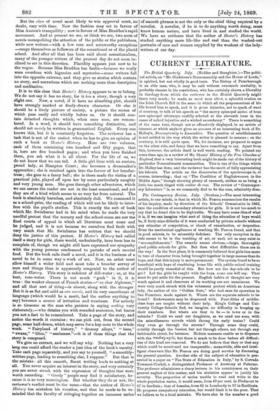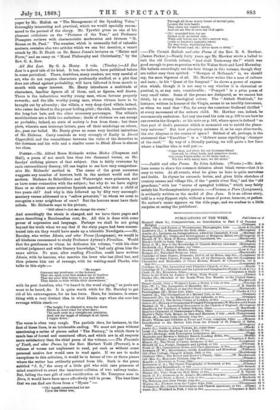The Contemporary Review. July. (Strahan.)—The most interesting article, to our
minds, is that in which Mr. Fearon summarizes the results of his inquiry, made by direction of the Schools' Commission in 1865, into the condition of secondary education for girls. It is not too much to say that he found this to be deplorable. We may have some idea of what it is, if we can imagine what sort of thing the education of boys would. be, if forty-nine-fiftieths of it were conducted by private schools without any stimulus of competition, or check of examination, or inspection. Even the mechanical appliances of teaching Mr. Fearon found, and that in good schools, to be miserably deficient. The only exception to the rule seems to be in the teaching of art, or such art as may exist in "accomplishments." The remedy seems obvious,—largo, thoroughly good public schools for girls. Bat then what difficulties there are in the way ! In the first place, it is commonly believed that girls lose more in tone of character from being brought together in large masses than do boys, and that this injury is more permanent. The system found to be so beneficial with boys of combining home life with public-school training would be partly remedial of this. But how are the day-schools to be got ? Let the girls be taught with the boys, some one will say. That must be put aside for the present. English habits of thought are very much against it and observers of its working are not unanimous. We were very much struck with the vehement protest which an American lady, the author of the "Golden Gate," who had seen its operation in San Francisco, made against it. Where are the separate schools to be. found ? Endowments may be dispensed with. Four-fifths of middle- class boys are taught without their help. King's College and Uni- versity College Schools, find, we imagine, no difficulty in keeping up their numbers. But where are they to be — in town or in the suburbs ? Could we send our daughters, as we send our sons, with the miscellaneous crowds which throng the early trains ? Could they even go through the streets ? Through some they could, notably through the busiest, but not through others, not through any fashionable street, for instance. Modern manners enable us to dispense with the Vaib ape/ S, but there is much to be done before all difficul- ties of this kind are removed. We do not believe that they or that any which could be mentioned are insuperable ; meanwhile, able and intel- ligent observers like Mr. Fearon are doing good service by discussing the general question. Another side of the subject of education is pre'. sented in a paper on "The State of Education in Italy," by S. Corrado Tommasi-Crudeli, a distinguished Professor of Anatomy at Palermo. The professor administers a sharp lecture to his countrymen on their general neglect of this matter, and his statistics appear to justify his severity. The proportion of males unable to read and write to the whole population varies, it would seem, from 49 per cent. in Piedmont to 87 in Sardinia ; that of females, from 65 in Lombardy to 97 in Basilicata. He proposes compulsory education, but would limit it to the poor. That we believe to be a fatal mistake. We have also in the number a good
paper by Mr. Hanish on "The Management of the Speaking Voice," thoroughly interesting and practical, which we would specially recom- mend to the perusal of the clergy. Mr. Tyrwhit gives us one of his pleasant criticisms on the "Pictures of the Year," and Professor Plumptre reviews with characteristic moderation and fairness "M. Ronan on St. Paul." The number, which is unusually full of valuable matters, contains also two articles which we can but mention, a -smart attack by Mr. D. Heath on Dr. Bence Jones's lectures on "Matter and Force," and an essay on "Moral Philosophy and Christianity," by the Rev. C. A. Row.































 Previous page
Previous page